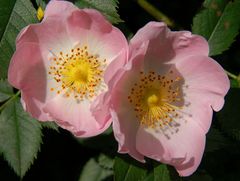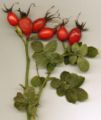Rosa canina
| Rosa canina subsp. var. | Dog Rose | |||||||||||||||||||||||||||||||||||||||||||||||||||||||
|---|---|---|---|---|---|---|---|---|---|---|---|---|---|---|---|---|---|---|---|---|---|---|---|---|---|---|---|---|---|---|---|---|---|---|---|---|---|---|---|---|---|---|---|---|---|---|---|---|---|---|---|---|---|---|---|---|

|
|
| ||||||||||||||||||||||||||||||||||||||||||||||||||||||
| ||||||||||||||||||||||||||||||||||||||||||||||||||||||||
Rosa canina (lit. Dog Rose, often called incorrectly Rosehip) is a variable scrambling rose species native to Europe, northwest Africa and western Asia.
It is a deciduous shrub normally ranging in height from 1-5 m, though sometimes it can scramble higher into the crowns of taller trees. Its stems are covered with small, sharp, hooked spines, which aid it in climbing. The leaves are pinnate, with 5-7 leaflets. The flowers are usually pale pink, but can vary between a deep pink and white. They are 4-6 cm diameter with five petals, and mature into an oval 1.5-2 cm red-orange fruit, or hip.
The wild plant is planted as a nurse or cover crop, or stabilising plant in land reclamation and specialised landscaping schemes.
| Standard Cyclopedia of Horticulture |
|---|
|
Rosa canina, Linn. Dop Rose. Upright shrub, attaining 10 ft. or more, with often recurving branches: prickles stout, hooked: lfts. 5-7, oval or elliptic, doubly serrate, glabrous or slightly pubescent or somewhat glandular beneath, 3/4 -1 1/2 in. long: fls. 1-3, light pink, on usually glabrous pedicels; sepals reflexed, caducous: fr. ovate, orange-reef, or scarlet, glabrous. June. Eu., N. Afr., W. Asia; naturalized in some localities.—Much used as stock for grafting. Var. exilis, Keller (R. exilis, Crepin). Low form with small lfts. about ?in. long, and small pink fls. about 1 in. across.
|
Cultivation
Propagation
Pests and diseases
Varieties
Numerous cultivars have been named, though few are common in cultivation. The cultivar Rosa canina 'Assisiensis' is the only dog rose without thorns.
Gallery
-
Leaf with stipules
-
Flowers
-
Hips
-
Hips
-
photo
References
- Standard Cyclopedia of Horticulture, by L. H. Bailey, MacMillan Co., 1963
External links
- w:Rosa canina. Some of the material on this page may be from Wikipedia, under the Creative Commons license.
- Rosa canina QR Code (Size 50, 100, 200, 500)




